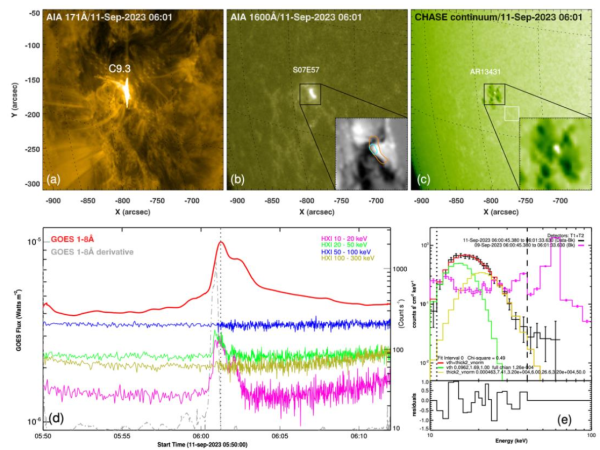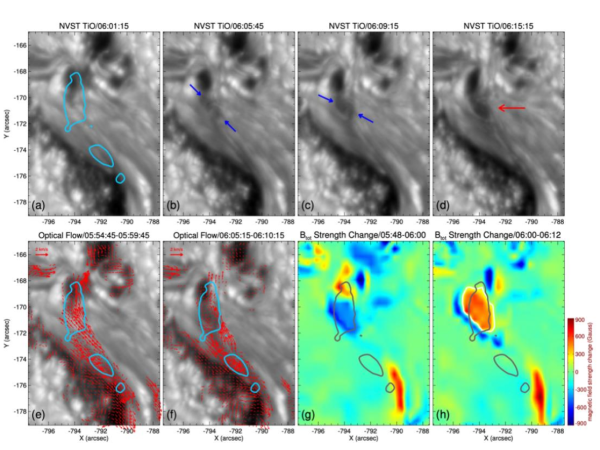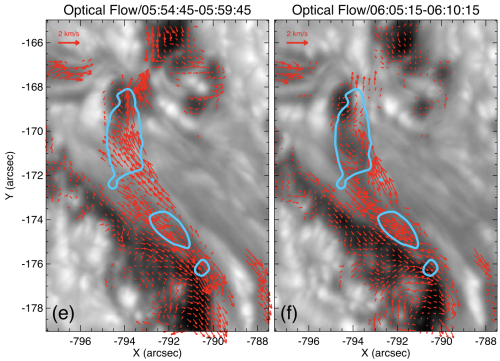High-Resolution Observations of a C3 class White-Light Flare
| Nugget | |
|---|---|
| Number: | 498 |
| 1st Author: | Zhe XU |
| 2nd Author: | Xiaoli YAN |
| Published: | June 16, 2025 |
| Next Nugget: | TBD |
| Previous Nugget: | The Sun's open-closed flux boundary and the origin of the slow solar wind |
Introduction
White-light flares (WLFs) are intense brightenings in the visible continuum and signify substantial energy deposition in the lower solar atmosphere. While typically associated with powerful X- and M-class flares, this study (Ref. [1]) presents the compelling case of a WLF in a relatively weak flare at GOES class C9.3, SOL2023-09-11T06:01. This event produced strong white-light signatures and photospheric impacts and was observed across the spectrum as shown in Figure 1.

This event, observed near the solar limb within NOAA AR 13431 on 11 September 2023, offered high-resolution insights thanks to coordinated observations by several space and ground-based observatories. Unlike typical electron beam-driven models, which often fall short of explaining photospheric effects, this event provides a new observational support for Alfvén wave pulses (Ref. [2,3]) as a viable energy transport mechanism during solar flares.
Multi-Instrument Observations
The WLF was captured simultaneously by several visible-light observers: the NVST TiO band at 7057 Å, the SDO/HMI continuum at 6173 Å, and the CHASE Fe I continuum level at 6569 Å. Two compact white-light kernels were observed aligned with the penumbral fibrils of a large sunspot, which further suggests photospheric involvement. Hard X-ray (HXR) data from ASO-S/HXI revealed that non-thermal electrons involved had energies below 50 keV and were insufficient alone to account for the observed white-light emission and photospheric magnetic field changes.
Alfvén Wave Signatures and Magnetic Field Amplification
The most remarkable aspect of this event is the detection of flare-induced vortex flows and a sudden magnetic-field amplification in the white-light kernel region (Figure 2). Optical flow analysis revealed a counterclockwise photospheric vortex, while vector magnetograms indicated a 400 G enhancement in magnetic field strength localized to the WLF core.

The energy required for this magnetic amplification (~4.1 x 1028 erg) is comparable to the estimated nonthermal electron energy, suggesting a shared energy reservoir. Based on observed perturbations and Alfvén wave theory, we estimate that the energy carried by Alfvén waves is on the order of 1030 erg. Only a small fraction reaches the photosphere, consistent with Alfvn wave dissipation in the chromosphere (Refs. [2,3]).
The observed spatial-temporal pattern of energy transfer, combined with the photospheric vortex responses, supports the idea that Alfvén waves can penetrate to the deep photosphere and contribute to white-light formation and magnetic field changes.
Conclusions
This study offers a clear observational link between Alfvén wave pulses and deep atmospheric responses during a solar flare. Even in a C-class event, the presence of white-light emission, photospheric vortex flows, and magnetic field enhancement point toward a multi-mechanism energy transport scenario, where both nonthermal electrons and Alfvén wave dissipation play critical roles
References
[1] "High-resolution Observations of a C9.3 White-light Flare and Its Impact on the Solar Photosphere"
[3] "Alfvénic Wave Heating of the Upper Chromosphere in Flares"
